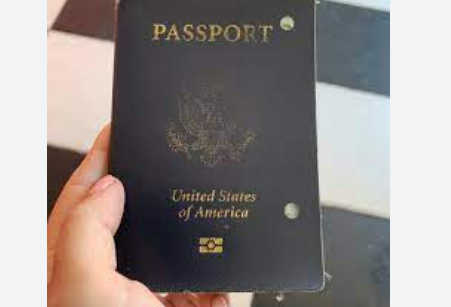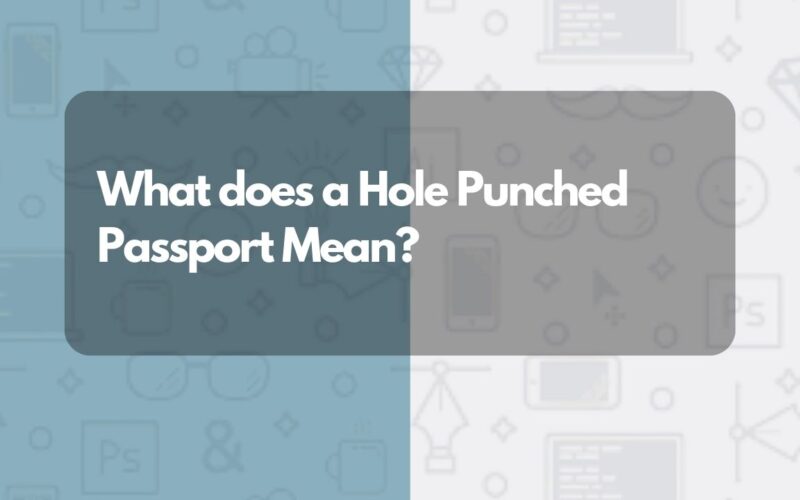As an Amazon Associate, I earn a small commission from qualifying purchases. Learn more about this.
When you see a book with a page ripped out, you might think it’s damaged. But what about a passport with a hole? It’s not broken, but there might be something behind it.
What does a Hole Punched Passport Mean?
Well, to put it simply: a hole-punched passport typically means that the passport is no longer valid for travel. This is usually a thing with old passports returned in the process of getting a new passport.
It’s a way for officials to visibly mark a passport as “canceled” or “expired” without having to take the entire document away. This is done easily since the passport number here is entirely different from your current passport.

But wait, why wouldn’t they just take the passport away? Good question! There are several reasons someone might keep their old, hole-punched passport:
- Proof of Past Travel: Even if a passport isn’t valid for future trips, it still has a record of your past journeys—those stamps and visas from previous travels. Many people like to keep these as mementos or proof of their trips.
- Secondary Identification: A hole-punched passport might no longer be useful for international travel, but it can still serve as an ID. For example, you could use it as a secondary form of identification, like when you’re setting up a bank account.
- Safety Net: Sometimes, when you renew your passport, there’s a period where you’re without a new one because it’s still being processed. In the meantime, having your old, hole-punched passport can be a bit reassuring, even if it’s no longer valid for crossing borders.
Now, if you’re the one with a hole-punched passport, never try using it as your main travel document.
You’ll need a valid, unpunched passport for that. And if you’re just curious about someone else’s hole-punched passport, well, now you know.
Is the Passport Completely Useless Now?
While a hole-punched passport can’t be used for travel, it’s not entirely useless. In fact, we have a detailed article where we talked about the use cases of old passports.
Additionally, even if the passport is no longer valid for travel, it can sometimes be used as a form of identification, although this varies from country to country and from one situation to another.
Always check local requirements if you plan to use an old, invalidated passport as an ID.
What to do if your Passport was Punctured Passport
1. Understand Why It Was Punched:
First things first, it’s essential to understand why your passport was hole-punched in the first place. As mentioned earlier, a hole usually signifies that the passport is no longer valid for travel. Common reasons for this could include:
- Expiry: Your passport has reached the end of its validity period. Keep in mind your passport doesn’t have to get to the actual expiry date before it’s invalidated.
- Renewal: You’ve applied for a new passport, and your old one was marked to prevent misuse.
- Reported Lost, Then Found: If you once reported your passport lost or stolen, but later found it and reported it as found, it might be hole-punched to prevent its usage since its details could have been flagged in international systems.
2. Secure a New Passport If You Haven’t Already:
If your passport was hole-punched due to renewal, you might already be expecting a new passport in the mail. If not, it’s important to apply for a new one as soon as possible, especially if you have travel plans on the horizon. The process varies by country, but usually, it involves:
- Filling out an application form.
- Providing required documents (like proof of identity and citizenship).
- Submitting a recent photograph that meets passport photo requirements.
- Paying a renewal fee. Do check your country’s official passport or immigration website for specific details on the process.
3. Handle with Care:
Even if it’s no longer valid for international travel, treat your hole-punched passport with respect. Remember, it still contains personal data. Here are some pointers on what to do with it:
- Keep It Safe: Store it with your other essential documents. It’s a record of your past travels and can be a wonderful memento.
- Use as Secondary ID: While you shouldn’t rely on it as your primary form of ID, it can still serve as a backup in certain situations.
- Don’t Try to Travel with It: This might sound obvious, but it’s worth stating clearly—don’t attempt to use a hole-punched passport for travel. It won’t be accepted, and you might face delays or issues at border controls.
Related: Here’s what happens when your passport address is different from your current address
4. Keep it as a Backup Until Your New Passport Arrives:
If you’re in that in-between phase where you’re waiting for a new passport, keep your hole-punched one on hand.
Even though you can’t travel with it, it can be handy to have it as a reference. It can provide details like your passport number, issuance and expiration dates, or past visas, which can sometimes be requested in various official scenarios.
Conclusion
A hole in a passport might seem unusual, especially if you’ve never come across one before. But it’s a standard practice in the world of travel. It’s a clear way to show that a passport isn’t valid anymore, without having to destroy the entire document.







